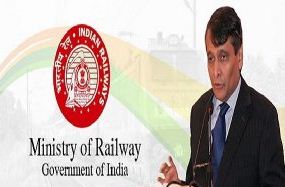The Cabinet Committee on Economic Affairs approved nine projects worth about Rs 24,000 crore on 24th August 2016 in nine states for expansion of railway network and connectivity across the country.
About Indian Railway :
Indian Railways is an Indian state-owned enterprise, owned and operated by the Government of India through the Ministry of Railways. It is one of the world’s largest railway networks comprising 115,000 km (71,000 mi) of track over a route of 67,312 km (41,826 mi) and 7,112 stations.
- In 2014-15, IR carried 8.397 billion passengers annually or more than 23 million passengers a day (roughly half of whom were suburban passengers) and 1058.81 million tons of freight in the year.
- In 2014–2015 Indian Railways had revenues of Rs.1,634.50 billion (US$24 billion) which consists of ₹1,069.27 billion (US$16 billion) from freight and₹402.80 billion (US$6.0 billion) from passengers tickets.

- Railways were first introduced to India in the year 1853 from Mumbai to Thane. In 1951 the systems were nationalised as one unit, the Indian Railways, becoming one of the largest networks in the world. IR operates both long distance and suburban rail systems on a multi-gauge network of broad, meter and narrow gauges.
- It also ownslocomotive and coach production facilities at several places in India, with assigned codes identifying their gauge, kind of power and type of operation. Its operations cover twenty nine states and seven union territories and also provide limited international services to Nepal, Bangladesh and Pakistan.
- Indian Railways is the world’s seventh largest commercial or utility employer, by number of employees, with over 1.376 million employees as of last published figures in 2013. IR’s rolling stock comprises over 245,267 Freight Wagons, 66,392 Passenger Coaches and 10,499 Locomotives (43 steam, 5,633 diesel and 4,823 electric locomotives).
- The trains have a 5 digit numbering system and runs 12,617 passenger trains and 7,421 freight trains daily.As of 31 March 2016, 27,999 km (17,398 mi) (41.59%) of the total 67,312 km (41,826 mi) route length was electrified.
Nine New Projects:-
The nine CCEA approved projects include the,
- 176 km long construction of second railway line between New Bongaigaon and Kamakhya
- 132 km long third line between Kharagpur (Nimpura) and Adityapur (Jharkhand)
- 228.3 km long construction of the third line between Rajnandgaon and Nagpur in Chhattisgarh and Maharashtra
- 273.80 km long third line between Mathura and Jhansi
- 152.57 km long third line between Jhansi and Bina,
- 280 km long third line between Itarsi and Nagpur,
- 201.04 km long third line between Ballarshah and Kazipet
- 287.68 km long third line between Vijaywada and Gudur
- 206 km long construction of fourth line between Jharsuguda and Bilaspur.
The move is aimed at creating a capacity to carry 1.5 billion tonne of goods by 2020. It is a huge capacity augmentation programme aimed at decongesting the main trunk routes for faster movement of coal, minerals, steel and other commodities and introduction of more mail and express trains.
- Third line/Fourth line projects approved are on North South and East West corridors on Golden Quadrangle which is fully saturated. These lines play an important role in transportation of freight and passenger traffic from Eastern and Southern regions to Northern and Western regions and vice versa.
- At present number of passenger and goods trains in this section are far more than its capacity, resulting in heavy detention to trains. The nine projects include seven 3rd line, one 4th line and one doubling. These projects are essentially required for removing capacity constraints, reducing detention and to cater for traffic growth in future.
Keys :
Suresh Prabhakar Prabhu : Railway Minister of India





